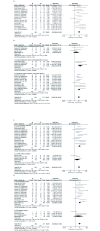Beneficial Effects of Caloric Restriction on Chronic Kidney Disease in Rodent Models: A Meta-Analysis and Systematic Review
- PMID: 26695411
- PMCID: PMC4690609
- DOI: 10.1371/journal.pone.0144442
Beneficial Effects of Caloric Restriction on Chronic Kidney Disease in Rodent Models: A Meta-Analysis and Systematic Review
Abstract
Background: Numerous studies have demonstrated the life-extending effect of caloric restriction. It is generally accepted that caloric restriction has health benefits, such as prolonging lifespan and delaying the onset and progression of CKD in various species, especially in rodent models. Although many studies have tested the efficacy of caloric restriction, no complete quantitative analysis of the potential beneficial effects of reducing caloric intake on the development and progression of CKD has been published.
Methods: All studies regarding the relationship between caloric restriction and chronic kidney diseases were searched in electronic databases, including PubMed/MEDLINE, EMBASE, Science Citation Index (SCI), OVID evidence-based medicine, Chinese Bio-medical Literature and Chinese science and technology periodicals (CNKI, VIP, and Wan Fang). The pooled odds ratios (OR) and 95% confidence intervals (95% CI) were calculated by using fixed- or random-effects models.
Results: The data from 27 of all the studies mentioned above was used in the Meta analysis. Through the meta-analysis, we found that the parameter of blood urea nitrogen, serum creatinine and urinary protein levels of the AL group was significant higher than that of the CR group, which are 4.11 mg/dl, 0.08mg/dl and 33.20mg/kg/24h, respectively. The incidence of the nephropathy in the caloric restriction (CR) group was significantly lower than that in the ad libitum-fed (AL) group. We further introduced the subgroup analysis and found that the effect of caloric restriction on the occurrence of kidney disease was only significant with prolonged intervention; the beneficial effects of CR on the 60%-caloric-restriction group were greater than on the less-than-60%-caloric-restriction group, and caloric restriction did not show obvious protective effects in genetically modified strains. Moreover, survival rate of the caloric restriction group is much higher than that of the ad libitum-fed (AL) group.
Conclusions: Our findings demonstrate for the first time that compared with the AL group, the caloric restriction indeed decreased urea nitrogen, creatinine, urine protein, incidence of kidney diseases and increased the survival rate on 700~800 days.
Conflict of interest statement
Figures






References
-
- H LG.. The consequences and costs of chronic kidney disease before ESRD. Journal of the American Society of Nephrology: JASN. 2004;15(5):1363–4. - PubMed
-
- H WE, D-D RN, H MD, C A, J K, B JF.. A stereological study of glomerular number and volume: Preliminary findings in a multiracial study of kidneys at autopsy. Kidney International. 2003;63(2):S31–S7. - PubMed
-
- Mulder W, Hillen H. Renal function and renal disease in the elderly:—Part I. European Journal of Internal Medicine. 2001;12(2):86–97(12). - PubMed
-
- Mccay CM, Crowell M, Maynard L, et al. The effect of retarded growth upon the length of life span and upon the ultimate body size. Nutrition. 1935; 10(8):63–79. - PubMed
-
- Partridge L, Brand MD. Special issue on dietary restriction: Dietary restriction, longevity and ageing—the current state of our knowledge and ignorance. Mechanisms of Ageing and Development. 2005;126(9):911–2.
Publication types
MeSH terms
LinkOut - more resources
Full Text Sources
Other Literature Sources
Medical

